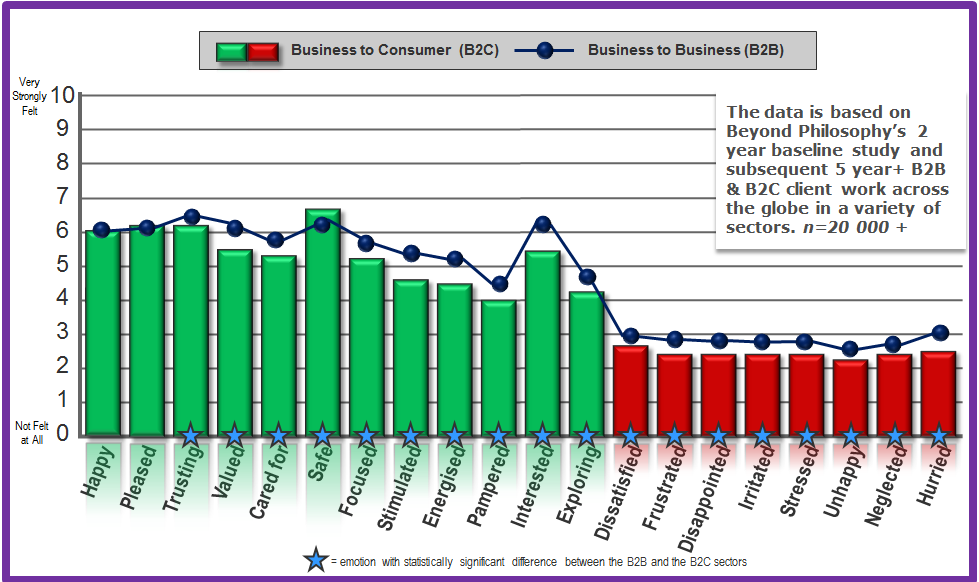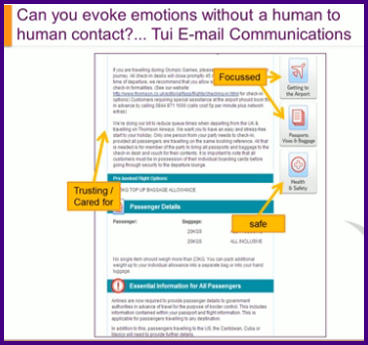If you answered Yes to that question, here’s the follow-on: Does the buyer feel the same kinds of emotions when they’re engaged in a B2B buying cycle as they do in a B2C cycle?
When B2B marketers discuss their sectors, we often hear statements like: “We base our decisions on data here.” “Our industry is straightforward; emotions probably don’t matter much.” “It’s all about the numbers.” There’s not much talk about emotions in the customer experience.
Colin Shaw and his team at Beyond Philosophy have spent years studying how emotions affect the buyer/seller relationship and using what they’ve learned to help organizations create engaging customer experiences. They explored their database to examine the emotions involved in B2C and B2B buying, and here’s what they found:

The green and red bars represent how consumers feel towards businesses they buy from (B2C). The higher the bar, the more that emotion is felt in the experience. The blue line with balls marks how business people feel as a client of other businesses (B2B).
When B2B and B2C emotions across the different areas were compared, there were statistically significant differences in every metric but two: B2B and B2C feel equally “happy” and “pleased.”
So what are those differences?
Looking first at the positive emotions, with the exception of “safe,” B2B buyers feel them to a greater extent than B2C customers. The emotions include trusting, feeling valued, cared for, focused, interested, and energized. This makes sense; in the mass B2C market, people are (for the most part) treated in a mass way. In the B2B world, they’re treated more personally. You have account managers who are rewarded when they build a relationship, earn the buyer’s trust, and close the deal. B2B generally has larger deals that warrant spending the time and money to research “influencers”, “gate keepers”, etc., and build personas. B2B marketers and sales reps target segments so they can personalize relationships and communications more; buyers respond with more positive emotions.
Types of risk
Most of the buying decisions we make as consumers have relatively low potential for negative consequences. A dress can be taken back. A CD that doesn’t satisfy can be given away. We buy time-based experiences (a hotel room, a night at the movies), commodities (paper towels, milk), and things that only one person depends on (that new motorcycle). And we’re spending our own money.
But B2B buyers are spending the company’s money. They have a team or a department or a division depending on what they purchase. If it fails…so do they, and it can be a career-damaging issue for big investments or wide-spread projects. Services are just as risky as goods. The buyer needs to interact with the supplier and manage them to a good performance as well. As you’ll note on the graph, B2B buyers feel less “safe” than B2C customers. That’s because their jobs are on the line.
The dark side
B2B buyers feel more stress, irritation and disappointment than B2C buyers. Again: the stakes are higher, the bets are bigger. Both reputation and return on investment are in play, and both really matter to that buyer. Many people go to bed and wake up with their work in mind and they are much more sensitive to anything that will impact their own work or put their job at risk.
Your takeaways
“We know half of customer experience is how a customer feels,” says Colin Shaw, CEO of Beyond Philosophy. “It’s not a rational thing, and it’s not just the standard place, price and promotion.”
One of the largest shipping companies in the world, Maersk Line, chose to focus on three target emotions that they felt drove the most value – trust, cared for, pleased. They did that to mark the transition from a transaction-driven “A to B” type organization to one that focuses on how customers feel. Three years after, the company had increased their Net Promoter Score by 40% points.

You can learn more about the roles emotions play in the B2B environment, including best practices in engaging customers emotionally and whether you can create positive motions without human-to-human contact in this on-demand webinar from Beyond Philosophy: “New research of top emotional touch points: Case studies of how to drive emotional engagement.”
The B2B organization’s need to create and maintain personal relationships is well-served by marketing automation. From list segmentation to website visitor tracking to personalized activity histories, marketing automation helps marketers and sales people understand their buyers as individuals with unique needs – so marketing can craft the right messaging, sales can create the right buying opportunity, and the customer experience can be optimized.
Are you consciously engaging your customers’ emotions? Have a story to share?